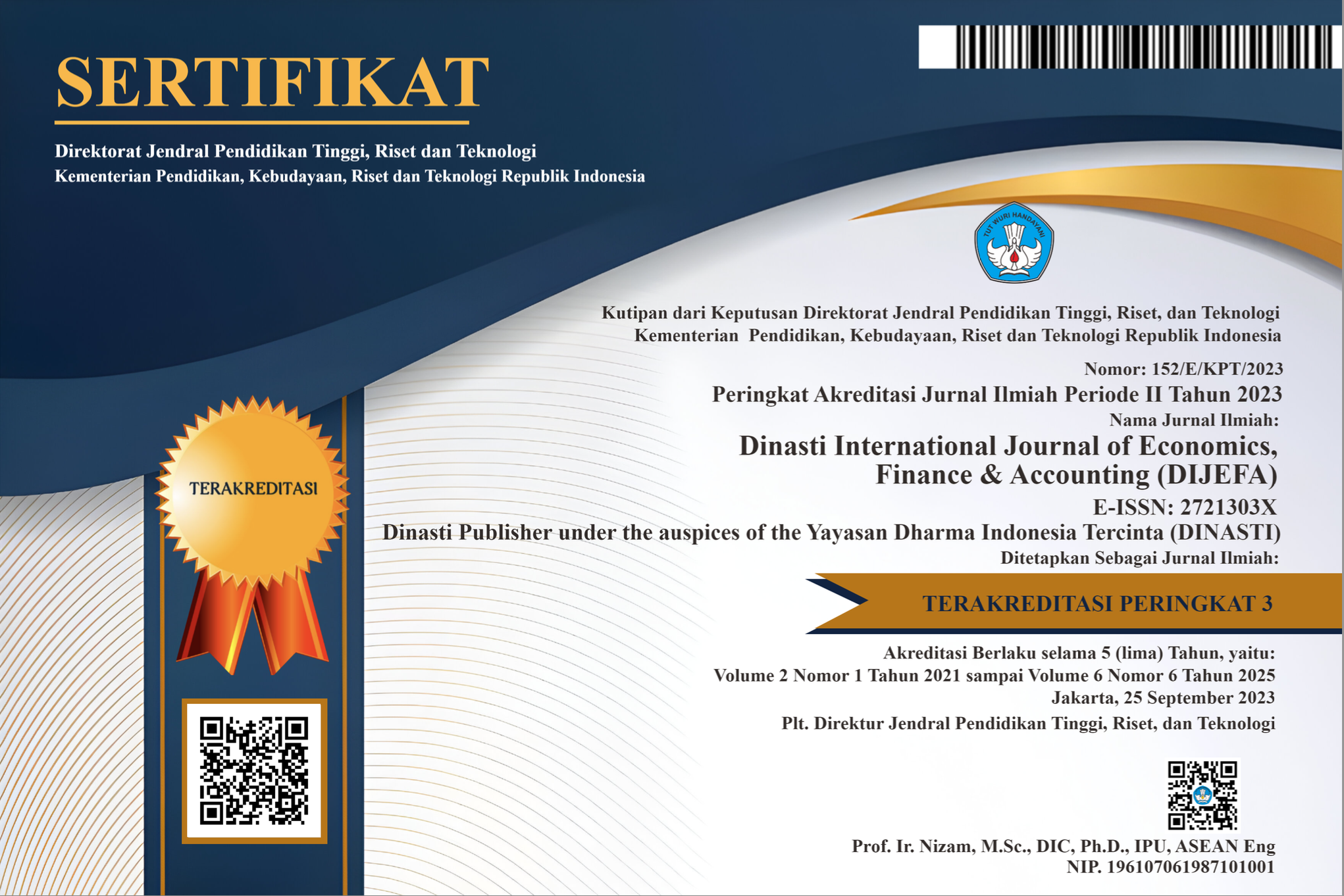Analysis Of The Possibility of Financial Statement Fraud: S.C.C.O.R.E Model
DOI:
https://doi.org/10.38035/dijefa.v6i2.4081Keywords:
S.C.C.O.R.E Model, M-Score, Financial Statement FraudAbstract
Financial statement fraud is an intentional act involving the omission of material information in financial statements. This action not only harms parties relying on financial statements but also benefits the perpetrators of the fraud. This study aims to examine the determinants of financial statement fraud using the S.C.C.O.R.E model approach. A total of 396 samples of manufacturing companies' financial statements from the 2021–2023 period were analyzed using logistic regression. The results reveal that financial stability (stimulus element), changes in directors (capability element), and total accruals (rationalization element) have a positive and significant influence on financial statement fraud. Meanwhile, other proxies such as related party transactions (collusion element), oversight effectiveness (opportunity element), and CEO photo frequency (arrogance element) do not affect financial statement fraud. This study provides practical contributions for practitioners, investors, regulators, and stakeholders in identifying the causes of fraud, thereby helping to design more effective fraud detection and prevention strategies in the future.
References
Abbas, M. T., & Laksito, H. (2022). Analisis Determinan Kecurangan Laporan Keuangan Menggunakan Perspektif Fraud Diamond Theory (Studi Kasus pada Perusahaan Manufaktur yang Terdaftar di BEI Tahun 2018-2020). Diponegoro Journal of Accounting, 11(4), 1–15.
ACFE. (2024). Occupational Fraud 2024: A Report to The Nations.
Achmad, T., Ghozali, I., Helmina, M. R. A., Hapsari, D. I., & Pamungkas, I. D. (2022). Detecting Fraudulent Financial Reporting Using the Fraud Hexagon Model: Evidence from the Banking Sector in Indonesia. Economies, 11(1), 5. https://doi.org/10.3390/economies11010005
Alfarago, D., Syukur, M., & Mabrur, A. (2023). The Likelihood of Fraud from The Fraud Hexagon Perspective: Evidence from Indonesia. ABAC Journal, 43(1), 34–51. https://doi.org/10.14456/abacj.2023.3
Beneish, M. D. (1999). The Detection of Earnings Manipulation. Financial Analysts Journal, 24–36.
Biduri, S., & Tjahjadi, B. (2024). Determinants of Financial Statement Fraud: The Perspective of Pentagon Fraud Theory (Evidence on Islamic Banking Companies in Indonesia). Journal of Islamic Accounting and Business Research. https://doi.org/10.1108/JIABR-08-2022-0213
CNBC Indonesia. (2024). Audit KAP Lapkeu Indofarma Temukan Fraud & Kerugian Rp 371 M. https://www.cnbcindonesia.com/market/20240525104850-17-541028/audit-kap-lapkeu-indofarma-temukan-fraud-kerugian-rp-371-m
Demetriades, P., & Owusu-Agyei, S. (2022). Fraudulent financial reporting: An application of fraud diamond to Toshiba’s accounting scandal. Journal of Financial Crime, 29(2), 729–763. https://doi.org/10.1108/JFC-05-2021-0108
Handoko, B. L., & Salim, A. S. J. (2022). Fraud Detection Using Fraud Hexagon Model in Top Index Shares of KOMPAS 100. Workshop on Computer Science and Engineering (WCSE 2022), 112–116. https://doi.org/10.18178/wcse.2022.06.017
Jannah, V. M., Andreas., & Rasuli, M. (2021). Pendekatan Vousinas Fraud Hexagon Model dalam Mendeteksi Kecurangan Pelaporan Keuangan. Studi Akuntansi & Keuangan Indonesia, 4(1), 1–16. https://doi.org/10.21632/saki.4.1.1-16
Kusumosari, L., & Solikhah, B. (2021). Analisis Kecurangan Laporan Keuangan Melalui Fraud Hexagon Theory. Fair Value: Jurnal Ilmiah Akuntansi dan Keuangan, 4(3), 735–767. https://doi.org/10.32670/fairvalue.v4i3.735
Maas, V. S., & Yin, H. (2021). Finding Partners in Crime? How Transparency About Managers’ Behavior Affects Employee Collusion. Accounting, Organizations and Society, 96, 1–20. https://doi.org/10.1016/j.aos.2021.101293
Mao, X., Liu, M., & Wang, Y. (2022). Using GNN to Detect Financial Fraud Based on The Related Party Transactions Network. Procedia Computer Science, 351–358. https://doi.org/10.1016/j.procs.2022.11.185
Novitasari, A. R., & Chariri, A. (2018). Analisis Faktor-Faktor yang Mempengaruhi Financial Statement Fraud dalam Perspektif Fraud Pentagon. Diponegoro Journal of Accounting, 7(4), 1–15. https://ejournal3.undip.ac.id/index.php/accounting/article/view/25572/22709
Nugroho, D., & Diyanty, V. (2022). Hexagon Fraud in Fraudulent Financial Statements: The Moderating Role of Audit Committee. Jurnal Akuntansi Dan Keuangan Indonesia, 19(1), 46–67. https://doi.org/10.21002/jaki.2022.03
Patmawati, P., & Rahmawati, M. (2023). Deteksi Financial Statement Fraud: Model Beneish M-Score, dan Model F-Score. E-Jurnal Akuntansi, 33(1), 34–44. https://doi.org/10.24843/eja.2023.v33.i01.p03
Ratmono, D., Darsono, D., & Cahyonowati, N. (2020). Financial Statement Fraud Detection with Beneish M-Score and Dechow F-Score Model; An Empirical Analysis of Fraud Pentagon Theory in Indonesia. International Journal of Financial Research, 11(6), 154. https://doi.org/10.5430/ijfr.v11n6p154
Sari, M. P., Mahardika, E., Suryandari, D., & Raharja, S. (2022). The audit committee as moderating the effect of hexagon’s fraud on fraudulent financial statements in mining companies listed on the Indonesia stock exchange. Cogent Business and Management, 9(1). https://doi.org/10.1080/23311975.2022.2150118
Shahzadi, K., Alim, W., & Khan, S. N. (2024). Do the Fraud Triangle Components Fuel Complex Financial Fraud? A Study of Nonfinancial Firms in Pakistan. Journal of Financial Crime. https://doi.org/10.1108/JFC-10-2023-0270
Situngkir, N. C., & Triyanto, D. N. (2020). Detecting Fraudulent Financial Reporting Using Fraud Score Model and Fraud Pentagon Theory: Empirical Study of Companies Listed in the L.Q. 45 Index. The Indonesian Journal of Accounting Research, 23(3), 373–410. http://doi.org/10.33312/ijar.486
Sukmadilaga, C., Winarningsih, S., Handayani, T., Herianti, E., & Ghani, E. K. (2022). Fraudulent Financial Reporting in Ministerial and Governmental Institutions in Indonesia: An Analysis Using Hexagon Theory. Economies, 10(4). https://doi.org/10.3390/economies10040086
Vousinas, G. L. (2019). Advancing theory of fraud: the S.C.O.R.R. model. Journal of Financial Crime, 26(1), 372–381. https://doi.org/10.1108/JFC-12-2017-0128
Wicaksono, A., & Suryandari, D. (2021). The Analysis of Fraudulent Financial Report Through Fraud Hexagon on Public Mining Companies. Accounting Analysis Journal, 10(3), 220–228. https://doi.org/10.15294/aaj.v10i3.54999
Yarana, C. (2023). Factors Influencing Financial Statement Fraud: An Analysis of the Fraud Diamond Theory from Evidence of Thai Listed Companies. WSEAS Transactions on Business and Economics, 20, 1659–1672. https://doi.org/10.37394/23207.2023.20.147
Downloads
Published
How to Cite
Issue
Section
License
Copyright (c) 2025 Sendifisda Faturochmah, Surya Raharja

This work is licensed under a Creative Commons Attribution 4.0 International License.
Authors who publish their manuscripts in this journal agree to the following conditions:
- The copyright on each article belongs to the author(s).
- The author acknowledges that the Dinasti International Journal of Economics, Finance & Accounting (DIJEFA) has the right to be the first to publish with a Creative Commons Attribution 4.0 International license (Attribution 4.0 International (CC BY 4.0).
- Authors can submit articles separately, arrange for the non-exclusive distribution of manuscripts that have been published in this journal into other versions (e.g., sent to the author's institutional repository, publication into books, etc.), by acknowledging that the manuscript has been published for the first time in the Dinasti International Journal of Economics, Finance & Accounting (DIJEFA).


























































